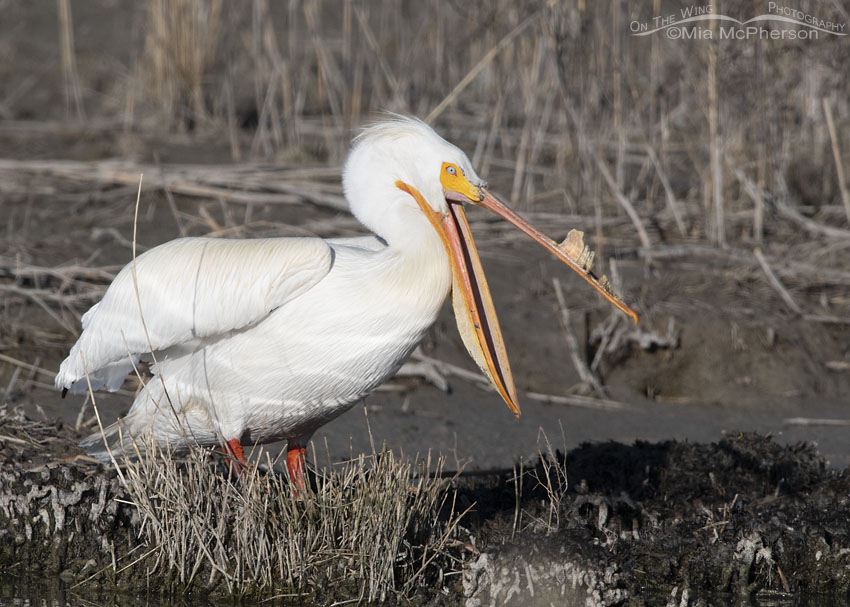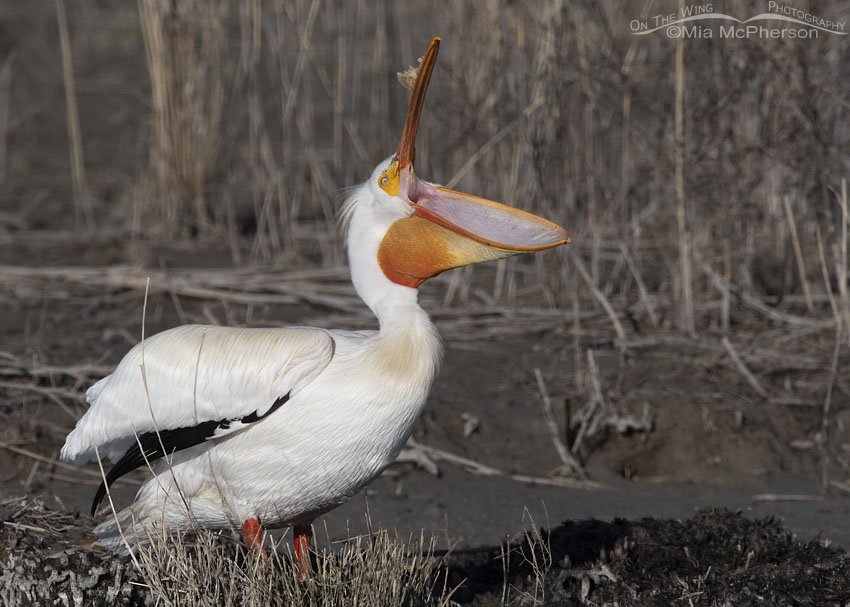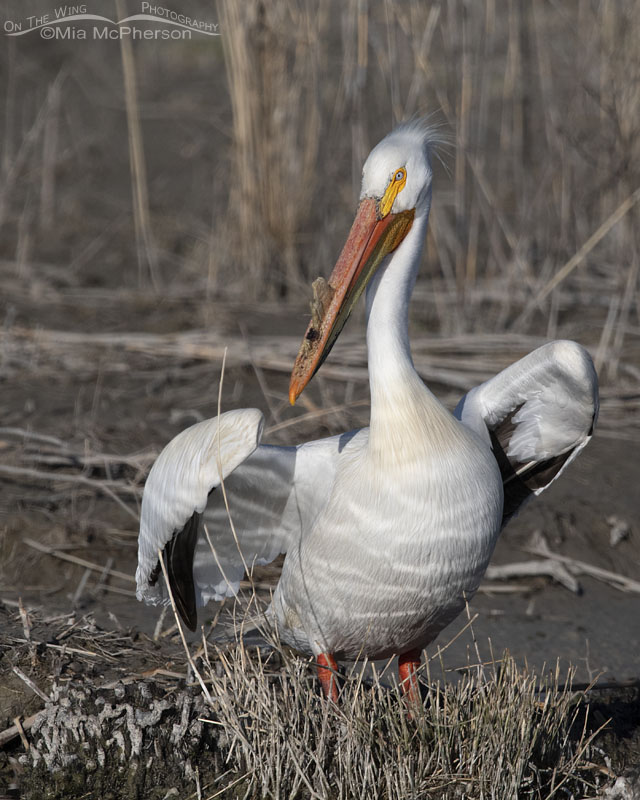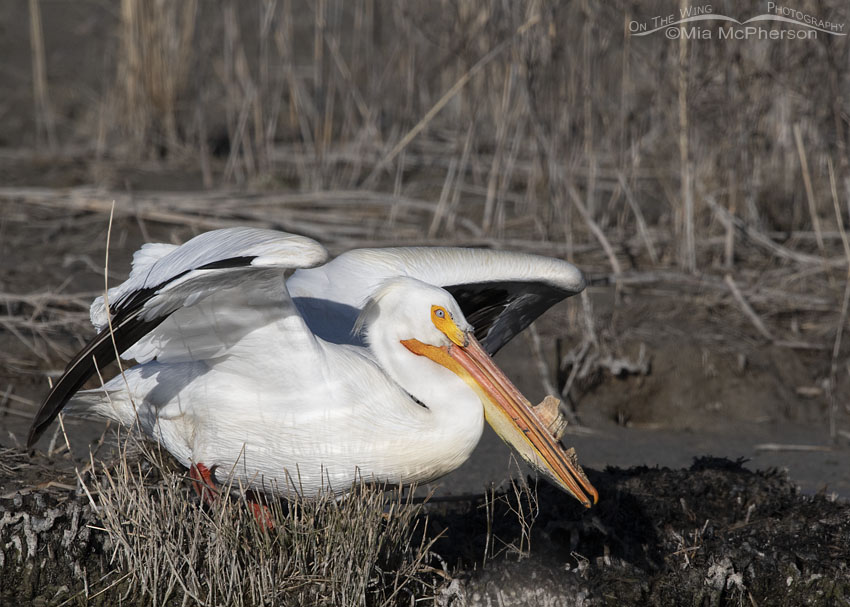Yesterday was my first opportunity this year to be able to take quality images of American White Pelicans in Definitive Alternate Plumage or as it is better known, breeding plumage.
 American White Pelican scratching its head – Nikon D500, f7.1, 1/4000, ISO 640, Nikkor 500mm VR with 1.4x TC, natural light
American White Pelican scratching its head – Nikon D500, f7.1, 1/4000, ISO 640, Nikkor 500mm VR with 1.4x TC, natural light
The radar/satellite was clear yesterday morning and it felt terrific to have two great days in a row to go out to photograph birds and yesterday morning Bear River Migratory Bird Refuge was my destination. I could see that the refuge was positively glowing in golden light even from the interstate and I was hoping to see and photograph lots of birds.
I got out of the “mobile blind” and used the bumper of the vehicle to brace my lens against to take these images because the pelican was on the west side of the road and to turn the vehicle around would have taken too much time and/or scared the pelicans away. I was hidden by the vehicle by getting out on the driver’s side. The pelicans don’t mind the vehicles as much as they do people on foot.
This pelican seemed to have an itch and scratched its head.
 American White Pelican in Definitive Alternate plumage with its bill open – Nikon D500, f7.1, 1/5000, ISO 640, Nikkor 500mm VR with 1.4x TC, natural light
American White Pelican in Definitive Alternate plumage with its bill open – Nikon D500, f7.1, 1/5000, ISO 640, Nikkor 500mm VR with 1.4x TC, natural light
This American White Pelican is in Definitive Alternate where they plumage develop a fibrous epidermal plate on their upper mandibles about one third of the way up their bills. Some people call them caruncles or horns and they are thought to be sexual ornamentation. This pelican’s “horn” shows well in this frame where the pelican opened its bill and shows the bluish-gray eye color off nicely too.
 American White Pelican with bill wide open – Nikon D500, f7.1, 1/8000, ISO 640, Nikkor 500mm VR with 1.4x TC, natural light
American White Pelican with bill wide open – Nikon D500, f7.1, 1/8000, ISO 640, Nikkor 500mm VR with 1.4x TC, natural light
I believe the pelican was simply yawning by opening its bill and pouch at this point or it could have been stretching its pouch.
 American White Pelican in Definitive Alternate plumage – Nikon D500, f7.1, 1/6400, ISO 640, Nikkor 500mm VR with 1.4x TC, natural light
American White Pelican in Definitive Alternate plumage – Nikon D500, f7.1, 1/6400, ISO 640, Nikkor 500mm VR with 1.4x TC, natural light
Some of the other pelicans near this one took flight and headed slight north about the time I took this photo and I wondered if this bird would follow them…
 Adult American White Pelican crouching to lift off – Nikon D500, f7.1, 1/6400, ISO 640, Nikkor 500mm VR with 1.4x TC, natural light
Adult American White Pelican crouching to lift off – Nikon D500, f7.1, 1/6400, ISO 640, Nikkor 500mm VR with 1.4x TC, natural light
And it did just a few frames later. I was close enough that I knew I’d clip wings and body parts when it lifted off with my teleconverter on but knew I wouldn’t have time to take it off, sure enough two frames after this one I was clipping wing tips!
I also took a tumble right after this pelican lifted off when I tried to stand up from my kneeling position. I hugged my lens and camera to protect it as I fell backwards onto the ground and my rear end while laughing at myself. Everything is okay, the only thing bruised was… well my knee. I’m fine, my gear is fine.
Life is good.
Mia
Click here to see more of my American White Pelican photos plus facts and information about this species.


What an absolutely fascinating series of pics. I had no idea American white pelicans grew an epidermal plate on their beaks. Is that growth unique to that particular species of pelican…or is it a common among all pelicans? [I hope that’s not a stupid question…].
By the way your narrative is wonderful. Thanks Mia.
Pelicans are such odd yet fascinating critters! These shots are so much fun — especially the yawn! Thank you for teaching me about breeding plumage (I was wondering what was up with that weird growth).
Glad you and your gear survived gravity’s pull unscathed. Gravity is definitely ahead on our matchups.
Wow. And of course you were protecting your gear. I am very glad that neither it nor you were hurt.
I had no idea about their breeding plumage! Thanks for the education! My goal is to learn at least one new thing every day and here we are!
Glad you didn’t get hurt and your gear, too. YAY YOU!
I hope you knee is better today. Funny how, as photographers (even amateurs like me), our first instinct is to protect the camera & lens. Fantastic shots of the White Pelican.
Lovely photos. I spent over an hour last Sunday photographing and just watching as they stretched preened and scratched. Delightful!
Interesting info…that Carunle looks like a piece of wood…it’s new to me. The yawning picture made me yawn. Glad you’re ok…and your gear!!!